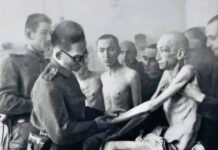Millions of historical events have contributed to creating the world we know today. Our school textbooks provide information on some of the grandest historical events but leave out others.
Some events sound so illogical that it appears like someone just made them up. So, we decided to bring to you 10 events in history that seem illogical but are true!
- Matthias Gallas was a military commander who in 1637 ordered his army to march into a wasteland with no food. Most of his soldiers starved to death. He repeated the same mistake in 1638 taking his army to the same wasteland.

Matthias Gallas is known in history as the “army wrecker” or “destroyer of armies.” He had led disastrous campaigns year after year and had destroyed numerous armies.
In 1629, Gallas led an army to Mantua. On their way, the army was attacked by the bubonic plague. All problems aside, the army was able to capture the city rather heroically.
Once the battle was over, Gallas realized that he was out of money to pay his army. He then requested the Austrian emperor for money but received a negative response. Finally, they had to surrender to the French.
In 1635, Gallas and his troops seized Zweibrücken. They captured the city for three months. Eventually, they ran out of food and the army starved to death. The ultimate blunder by Gallas was in the years 1637 and 1638.
In this battle, Gallas commanded against Banér, a Swedish General. Gallas and his troops attacked the same wasteland twice, ran out of food, and the majority of the army starved to death. It’s hard to believe that an experienced general would make the same mistake twice. Gallas made a complete failure of the battle, lost his command, and was subjected to ridicule.
A popular belief among historians is that Gallas’ alcoholism played a major role in his incompetence. Although he did so well in numerous battles, his lack of ability to have a long-term plan ended up destroying his army several times.
- There were two Mongol invasions of Japan that were stopped both times by typhoons, the tropical storms.

A storm aiding in defeating the enemy army? And twice? This might sound a little bizarre, but the explanation behind the same makes it less bizarre.
When the Mongols invaded for the first time, they were able to successfully conquer Tsushima and Iki Islands in Japan. When they moved on to Hakata Bay, the armies of samurai clans offered extreme resistance to the Mongol army and forced them to withdraw. The Mongols were hit by a typhoon during their withdrawal. The majority of the ships sank and numerous soldiers drowned.
The Mongols returned again seven years later. By this time, the Japanese had constructed tall walls to protect themselves from future assaults. The Mongols faced difficulty in landing due to the walls and they had to stay afloat for months.
Their supplies were depleting and they were still looking for landing space. Being exposed to the waters, they were hit again by a great typhoon known as “kamikaze.” More than 70,000 of the Mongol army was captured and they never tried to attack Japan again.
- Lichtenstein’s army once invaded Italy with 80 men and returned with no casualties and 81 men.

Liechtenstein is one of the few countries in the world without a military. But during the Middle Ages, the country saw a lot of attacks. Turks attacked the country twice in 1529 and 1683. The nation gained independence in 1806.
Even though the country gained independence, it was not completely free until 1813. The country was first occupied by France, then Russia, and followed by France again. The country’s last military assignment was in 1886 during the Austro-Prussian War.
Although the army refused to fight fellow-Germans, they had to send 80% of their army of 100 men to defend the Tyrol against a possible invasion by Italy. The 80 men sent there did not see any action and returned with no casualties.
But a surprising thing happened. 80 men went to fight but returned with 81! It is believed that either an Austrian or an Italian soldier decided to join the Lichtenstein army and went home with them! This doesn’t happen much, does it?
- During WWII, when Sergeant Leonard A. Funk was confronted by 90 German soldiers, he began to laugh hysterically at the situation. Many of the enemy soldiers joined him in laughter, until Funk wiped them out with his machine gun, gunning down 21 and capturing the rest.

Sergeant Leonard A. Funk was a recipient of the United States Army Medal of Honor and was one of the most decorated soldiers of World War II. It was January of 1945. Funk’s company was sent to Belgium to contain a German breakout. The company had to march in heavy snow for about 15 miles. The executive perished on the road and Funk took over the command.
There were not many infantrymen to hold against the Germans, so Funk decided to hire people from the company office. Most of the new hires were desk clerks! With a platoon of 30 clerks, Funk was able to capture 30 Germans. Another team had captured 50 Germans, and prisoners from both the teams were put in the yard of a house. Four US soldiers were left to guard them, and Funk returned to fight.
In the meantime, a German patrol came by and fooled the four guards by wearing camouflage capes similar to the American troops. They freed the prisoners. Funk had no idea about this and came back to check on the prisoners. As soon as he walked into the yard, a German officer shoved a pistol into Funk’s gut. Funk took everyone by surprise by starting to laugh out loud.
The story goes that the more he laughed the angrier the German officer got. The officer started shouting at Funk in German and Funk continued to infuriate him by laughing hard. Soon the other enemy soldiers joined in on the laughter.
After some time when Funk finally gained his composure, he went ahead to unsling his gun in an act of surrender. But in a swift motion, he emptied an entire magazine into the German officer! By the time the Germans realized what happened, Funk had ordered his men to pick up any weapon they could find and open fire. His troop was able to kill 21 Germans, wounded 24, and captured the rest. Funk was later heard saying. “That was the stupidest thing I’ve ever seen.” Sounds like a comedy movie plot, doesn’t it? But it’s so true!
- People repeatedly attacked Russia during the winter. The winter climate of Russia has been a contributing factor to the military failures of several invasions of Russia giving rise to the term “General Winter.”

Why attack a place again and again at the same dreadful time? This refers to the several military invasions of Russia during the winters. The winter climate in Russia is harsh, and all the invasions that have taken place at that time have been complete failures.
During the Swedish invasion of 1707, the winter at that time was the most brutal of the 18th century. The seaports froze, and 35,000 Swedish troops were crippled by the cold. When spring arrived, only 19,000 were alive. The Russians responded via the Battle of Poltava in June 1709 and put an end to the Swedish Empire.

Napoleon invaded Russia in 1812. They started the invasion in the summer of June 1812. The Russians did not face the French directly, and instead, they burnt all their crops and villages so that the French could not use them. When winter struck, his army suffered even more disastrous losses.
His army of 610,000 men was reduced to just 100,000. You would think that after hearing about the harsh winter conditions, invasions would stick to summers. But no! During the winter of 1918–19, the Allied forces and the Bolshevik Red Army thought they had gained enough expertise on winter warfare and went ahead to invade Russia.
Both suffered at the hands of the harsh winter. The same fate awaited when Hitler invaded Russian in 1941. His army had already suffered 734,000 in casualties and their supplies were running low even before winter arrived.
This is where the terms “Russian Winter,” “General Winter,” “General Frost,” and “General Snow” were born.
- A single Soviet tank held off an entire German division for one day in the Battle of Raseiniai in 1941.

The Battle of Raseiniai was fought between the Germans and the Russians to take control of the river crossings near the village of Raseiniai. The most prominent element of this battle was the tanks.
The Germans had 245 and the Russians 749! The Russians had heavy-duty tanks – the KV-1 and KV-2. If the Germans had not received air support of the Luftflotte 1, then it would have been impossible for them to face the fury of the Russian tanks.
This is the story of one such brave Russian KV tank, that held off an entire German division for a complete day. According to the locals, this single tank drove up to its location, stopped, and sat waiting for the Germans. When the Germans arrived, the tank open fired.
When the Germans were unable to proceed, they thought that it’s better to wait it out as at some point the tank was going to need supplies. But the tank did not move. It just sat there and blew up everything that the Germans sent its way. Imagine how brave the crew of the KV tank were to have sat in the blazing heat for hours inside the tank with sounds of gunshots ringing in their ears throughout the day.
Finally, after many hours, one of the German soldiers noticed a hole in the KV’s armour. He threw a grenade through the hole killing the entire crew of the KV. Six soldiers were found dead. The Germans buried their enemy out of respect for such a brave act. These six crew members might have been the toughest warriors they encountered throughout the entire battle.
- Napoleon managed to escape from his exile on the island of Elba, reached France, turned the army that was sent to capture him to his side, and ruled Paris for 100 days.

Napoleon’s escape story sounds completely fake but believe it or not, it’s completely true. The representatives of the Austrian Empire, Russia, and Prussia signed the Treaty of Fontainebleau in which they exiled Napoleon to a remote island. He was cut off from his wife and son and banished to Elba.
During his exile on the island, Napoleon’s allowance was cut-off, and he heard rumours that he will be banished to a more remote island on the Atlantic Ocean. Fearing the rumour was true, Napoleon escaped from Elba with 700 men. Its quite strange that even in exile, Napoleon was able to form an army of 700 men!
He landed on the French mainland two days after his escape. There he encountered the 5th Regiment serving Louis XVIII who was sent to intercept him. Upon seeing the army, Napoleon shouted, “Here I am. Kill your Emperor, if you wish.”
With these mere words, the entire army turned in support of Napoleon! The soldiers exclaimed, “Vive L’Empereur!” Napoleon marched to Paris with his new army and King Louis XVIII had to flee to Belgium upon realizing that he had lost his army. Napoleon ruled Paris for 100 days after that and expanded his army to 200,000 men.
Things started getting sour after that. Great Britain, Russia, Austria, and Prussia assigned troops to capture Napoleon dead or alive. So, Napoleon tried to escape to the United States. His plan did not work out, and he was exiled again on the island of Saint Helena where he breathed his last.
All things aside, the story of his escape from Elba to ruling Paris for 100 days seems quite illogical. Is it so easy to turn an entire army to your side? Maybe, maybe not. But all we know is that Napoleon was able to do exactly that!
- Tycho Brahe was a Danish astronomer who lost part of his nose in a duel, hired a dwarf to be his assistant/pet, and died from a ruptured bladder from holding his pee for too long. Professionally, he is famous for his accurate and comprehensive astronomical and planetary observations.

A smart man with a foolish brain? That’s not even a real thing! But listening to Tycho Brahe’s life story might just give that feeling. Brahe is one of the most prominent scholars in the field of astronomy. He had provided numerous, accurate readings on celestial occurrences. Even though he was a star in his profession, his personal life seems a bit foolish.
When Brahe was studying medicine, he got into a sword duel against a fellow Danish nobleman. Whatever they were fighting for, it resulted in Brahe losing the bridge of his nose! Throughout his life, he had to wear a prosthetic nose that was made out of brass. Why a medical student would agree to a sword duel is beyond one’s understanding!
Another bizarre element of Brahe’s life was him keeping a dwarf person as his assistant and occasionally treating him as his pet. According to historical accounts, the dwarf called “Jeppe” or “Jep” used to sit at Tycho’s feet when he was working and received a morsel now and then from Brahe. Jep also performed as his psychic. Weird, isn’t it?
In 1601, Brahe died on 24 October, 11 days after attending a banquet in Prague. It is said that during the banquet Brahe refused to go to the bathroom out of etiquette. When he reached home, he was no longer able to relieve himself and suffered from excruciating pain.
Although preliminary investigations suggested that Brahe died from mercury poisoning, it was later established that a ruptured bladder was the cause. Records show that Brahe wrote his own epitaph, “He lived like a sage and died like a fool.” He got that right!
- King Peter I of Portugal had the love of his life exhumed from her grave, dressed, and crowned her like a queen and made the entire court pay homage to their new queen.

King Peter I of Portugal was the son of King Afonso IV. Afonso was an adamant ruler and wanted things to work the way he wanted. So, when Peter fell in love with Inês Piras de Castro, Afonso declared this as illegitimate and forbade Peter from marrying her.
But Peter claimed that he did it anyway which made the king furious. The king then ordered Inês to be banished from court and confined in a monstery. There, in 1355, he ordered three of his henchmen to take her life.

Two years after this incident, Afonso breathed his last. This made Peter the new king. He soon embarked on a mission to find the killers of his beloved Inês. Two of the killers were caught while the third one escaped. It is said that descendants of the third killer who was not caught celebrate his escape with a picnic every June!
Once Peter was satisfied that the killers were brought to justice, he had Inês exhumed. He then ordered the corpse to be dressed as a queen and had her crowned. All the people in his court were made to take her hand and kiss it to show their respect and allegiance to the new queen. The question that echoes from these events is why though? Was it supposed to be an act of love or a slight hint of insanity?
- Audie Murphy was one of the most decorated soldiers of WWII. At the age of 19, he managed to single-handedly hold off an entire company of German troops for an hour and then counterattacked and won while being wounded and out of ammunition. When the war ended, Murphy had a 21-year long acting career.

An injured 19-year-old single-handedly managing to keep the enemy at bay? That’s the story of Audie Murphy. Murphy received many awards for his service in the army during WWII.
During one such occasion, a place known as “The Colmar Pocket” was held by German troops. The troops had been there since November 1944. In January 1945, Murphy joined with the US platoon that was stationed in Colmar. The German troops attack them, and Murphy was wounded in both his legs. Murphy’s platoon retreated and decided to wait for reinforcements. Also, Murphy was made the commander of the troops.
When the Germans attacked again with an M10 tank, Murphy ordered his men to retreat into the woods. He remained behind alone at his post and kept shooting his M1 carbine at the Germans. Remember, he was wounded in both legs during this time.
But he never gave up. He was able to kill a squad of German soldiers who were proceeding towards him by crawling through a ditch. He wounded over 50 Germans! He stopped only after he ran out of ammunition.
He went back to his men and led them back to fight the Germans completely ignoring his own injury. For his bravery on that day, Murphy received the Presidential Unit Citation and was awarded a Bronze Oak Leaf Cluster. After the war, Murphy had a successful acting career from 1948 to 1969. He was featured in more than 40 movies and one TV series.
Follow the Neptune Prime channel on WhatsApp:
Do you have breaking news, interview request, opinion, suggestion, or want your event covered? Email us at neptuneprime2233@gmail.com





